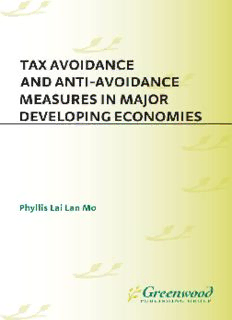
Tax Avoidance and Anti-Avoidance Measures in Major Developing Economies PDF
Preview Tax Avoidance and Anti-Avoidance Measures in Major Developing Economies
Tax Avoidance and Anti-Avoidance Measures in Major Developing Economies This page intentionally left blank Tax Avoidance and Anti-Avoidance Measures in Major Developing Economies PHYLLIS LAI LAN MO FOREWORD BY TANG YUNWEI Wes port Con PRAEGER ' - ES Library of Congress Cataloging-in-Publication Data Mo, Phyllis Lai Lan, 1959- Tax avoidance and anti-avoidance measures in major developing economies / Phyllis Lan Mo ; foreword by Tang Yunwei. p. cm. Includes bibliographical references and index. ISBN 1-56720-577-1 (alk. paper) 1. Tax administration and procedure—Developing countries. 2. Tax evasion— Developing countries. 3. Taxation—Developing countries. I. Title. HJ2351.7.M6 2003 336.2'06'091724—dc22 2003057993 British Library Cataloguing in Publication Data is available. Copyright © 2003 by Phyllis Lai Lan Mo All rights reserved. No portion of this book may be reproduced, by any process or technique, without the express written consent of the publisher. Library of Congress Catalog Card Number: 2003057993 ISBN: 0-56720-577-1 First published in 2003 Praeger Publishers, 88 Post Road West, Westport, CT 06881 An imprint of Greenwood Publishing Group, Inc. www.praeger.com Printed in the United States of America The paper used in this book complies with the Permanent Paper Standard issued by the National Information Standards Organization (Z39.48-1984). 10 9 8 7 6 5 4 3 21 Contents Tables vii Foreword by Tang Yunwei ix Preface xi 1 The Nature and Emerging Significance of Tax Avoidance 1 in Developing Economies Chapter Overview 1 General Concepts on Tax Avoidance and Evasion 2 The World Economy 4 The Level of Damages Arising from Tax Avoidance by Foreign 6 Investors in Developing Economies Environmental Problems for Tax Avoidance in Developing 12 Economies 2 Tax Systems in Major Developing Economies 15 Chapter Overview 15 Tax System in China: Implications for Foreign Investors 19 Tax System in India: Implications for Foreign Investors 37 Tax System in Brazil: Implications for Foreign Investors 48 Tax System in Mexico: Implications for Foreign Investors 60 Summary Comparisons 71 3 Tax Avoidance and Anti-Avoidance Measures 77 Chapter Overview 77 Tax Avoidance and Anti-Avoidance Measures in China 78 VI CONTENTS Tax Avoidance and Anti-Avoidance Measures in India 104 Tax Avoidance and Anti-Avoidance Measures in Brazil 115 Tax Avoidance and Anti-Avoidance Measures in Mexico 123 4 An Empirical Study on Tax Noncompliance in China 133 Chapter Overview 133 Prior Research on Tax Noncompliance Behavior 134 Nature of Tax Audit Adjustments 136 Environmental Factors Affecting Tax Noncompliance in China 139 Research Methodology 145 Empirical Results 148 ANOVA Results 156 Conclusion 162 5 Summary and Implications 165 The Need for a Comprehensive Understanding of Tax Avoidance 165 and Anti-Avoidance Measures in Developing Economies Summary of Country Studies 166 Empirical Study on Tax Noncompliance in China 169 Implications of This Study 169 Appendix 1 Translated Extracts of Income Tax Law of the 173 People's Republic of China Concerning Foreign Investment Enterprises and Foreign Enterprises Appendix 2 Translated Extracts of Tax Administration and 181 Collection Law of the People's Republic of China Bibliography 197 Index 205 Tables 1.1 Average Annual Percentage Growth of Real GDP 5 1.2 Value and Annual Growth of China's Foreign Trade 6 1.3 Top Ten Largest Recipients of Foreign Direct Investment 8 in the World 1.4 Import and Export by Foreign Investment Enterprises 10 in China 2.1 Comparative Tax Systems 72 3.1 Tax Revenue to GDP Ratio in China (1991-2000) 79 3.2 Tax Revenue to GDP Ratio in India (1996-2000) 104 3.3 Summary of Tax Amnesties in India 109 3.4 Tax Revenue to GDP Ratio in Brazil (1997-2001) 115 3.5 Tax Revenue to GDP Ratio in Mexico (1996-2000) 124 4.1 Nondeductible and Conditionally Deductible Expenses 137 for Calculating Taxable Income of FIEs in China 4.2 Pearson Correlation Coefficients among Independent 149 Variables 4.3 Descriptive Statistics of Tax Audit Adjustments by 150 Environmental Factors 4.4 ANOVA Results 157 4.5 Marginal Means for Statistical Significant Relationship 158 between Dependent and Independent Variables This page intentionally left blank Foreword Tax avoidance and anti-avoidance measures are matters of major concern for tax authorities and corporate management. This concern is particularly seri ous for developing countries given the rapid growth of investment in their economies and their lack of adequate experience in dealing with the problem. This innovative study by Professor Mo goes a long way addressing this concern by enhancing our understanding of the tax environment and enforce ment, including auditing in four major developing economies, namely, China, India, Brazil, and Mexico. As far as can be determined, this is the first com prehensive comparative study on tax avoidance in developing economies. More specifically, this book provides a comparative analysis of the business and tax systems in these economies, and the tax avoidance problems and anti- avoidance measures taken by respective tax authorities. This book also pro vides empirical evidence on tax avoidance by multinational corporations in China as well as an empirical assessment of the impact of public policies on tax avoidance by foreign investors. Reading this in-depth study is the obvious and indispensable first step in gaining appropriate knowledge of the tax avoidance and enforcement prob lems in developing economies. Accountants, auditors, finance managers, public policy makers, and business practitioners as well as researchers should gain substantially from the insights provided in this book. Tang Yunwei Managing Partner Ernst & Young Dahua Certified Public Accountants Co. Ltd Shanghai, The People's Republic of China
Description: